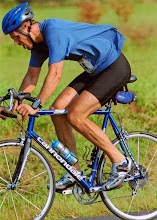
The last major tournament of the professional tennis season is concluding this weekend at the U.S. Open in New York.
Roger Federer has made his way into the semi-finals. That is no surprise. Federer is arguably the greatest tennis player of all time. His 16 major titles including 6 Wimbledon championships and 5 consecutive U.S. Opens have made him a familiar name even to tennis newbies.
Take a few minutes to watch part of a Federer match this weekend. Not just for his grace, quickness, agility and total command of the sport. No, I actually want you to look at Federer himself. In case you can’t see a match this weekend, I’ve included a picture below.
What I want you to notice is the massive difference in the size of his left arm (bicep and forearm) and his right arm. His right arm is muscled and thick like Popeye’s. His left arm is thin and wiry like Olive Oil’s. You would never think the two arms belong to the same person.
Federer is right-handed, meaning he hits all of his shots with the racket in his right hand. For a professional player that means he is hitting literally thousands of shots every day with his right arm and doing little, if anything, with his left arm.
Federer has a huge muscular imbalance. In general, muscular imbalances are a bad thing. They cause a person to rely on the stronger muscle set and that can lead to problems in other parts of the body. For example, a person with a muscle imbalance that favors their right arm will tend to carry heavy things (a briefcase or a piece of luggage) with the stronger arm. This forces core muscles to be overused to support lifting with the right side of the body, it causes muscles in the upper back and neck on the right side to be overused and it can lead to shifting of the hips while walking. All of these can create muscle imbalances throughout the body.
For many professional athletes, imbalance is common. Baseball pitchers, golfers and others repeat the same motion over and over throughout the year to the point where they couldn’t possibly spend enough time using the opposite arm to correct the imbalance.
As a non-professional athlete, however, you need to work to keep your muscles in balance. Here are some simple tips to keep your body evenly strong and looking symmetrical.
1) Use dumbbells for strength exercises. Using machines or barbells permits one side of the body to push harder than the other. Using dumbbells isolates the same amount of weight in each hand and forces symmetrical movement during the exercise.
2) Practice performing exercises standing on one leg (once you’ve mastered the exercise on two legs). This forces each leg to strengthen and improve balance independently of the other leg.
3) When doing an exercise like a lunge, make sure you are completing a full range of motion with each stride. Many people will limit their range of motion on the weaker side.
4) Always choose an equal amount of weight for each arm when using dumbbells. Do not increase the weight until you are able to do a full range of motion with great form on each side. The strong arm may be ready to progress to a heavier weight but in the long run it is best to keep both arms progressing together.
5) Take some time off from your sport during the off-season. If you do participate in a sport that requires emphasis on a one-sided motion, make sure that during the off-season you work to bring your body back into balance. Baseball pitcher Barry Zito begins working on exercises to get his body back in balance immediately after the season ends.
If you have questions please contact Active Personal Fitness at 267.626.7478. We offer in-home personal fitness training and group exercise classes throughout Central Bucks.
If you are an area tennis player, make sure you visit 40 Love Pro Shop in Doylestown. You can earn a $75 gift certificate for our classes or personal training if you become a regular at their shop!!
Be well,
Paul
www.ActivePersonalFitness.com

